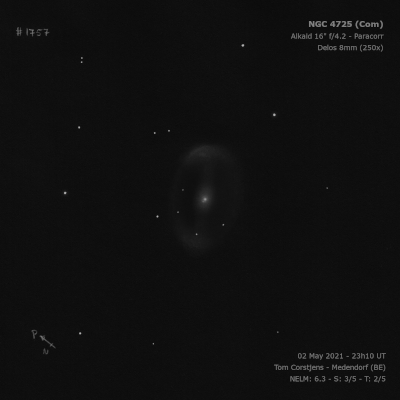
William Herschel discovered NGC 4725 = H I-84 = h1451 on 6 Apr 1785 (sweep 393) and recorded "cB, iR, 7 or 8' the longest way, the brightness confined to a small spot; the rest being milky nebulosity."
Johnstone Stoney, Lord Rosse's assistant, discovered spiral structure on 9 Mar 1850. NGC 4725 was included in the list of "Spiral or curvilinear" nebulae in LdR's 1850 PT paper. The following February, Bindon Stoney logged "Spiral, 2 arms and some stars in following arm." On 15 Apr 1858, R.J. Mitchell wrote "vL and vB. The centre itself it like an E neb with Nucl; the centre is enveloped is an irr ring or rings of nebulous light as in the accompaning rude sketch, which does not contain all the details." His sketch clearly shows the inner ring was resolved. On 3 May 1858, he added "The surrounding ring of nebulosity is of irregular shape, it curves gently at delta (south preceding end) but bends more sharply at gamma (north following end), where it is brightest. The centre seems to reach up to and to blend with the nebulosity at delta."
300/350mm - 13.1" (5/26/84): very bright, impressive, very small bright core, elongated SW-NE, large halo. Structure is suspected with the WSW edge possibly brighter. NGC 4712 lies 12' WSW.
400/500mm - 18" (5/12/07): very impressive spiral structure visible. Two arms emerge from the very bright oval core. One arm is attached at the northeast end of the core and sweeps to the north before hooking back to the west. Three faint stars are superimposed along this arm. A second broader arm is attached at the southwest end of the core. This arms heads south before hooking towards the east. Both arms have brighter patches or arcs near the ends of the major axis.
900/1200mm - 48" (5/3/19): very bright, very large, oval 3:2 SSW-NNE, strong concentration with a very bright oval core and an intense nucleus. The inner ring (interpreted as spiral arms in my 18" observation) was very obvious and highlighted by bright arcs or "handles" at the southwest and northeast ends. The ring dimmed on the east side but could be traced between the two arcs. The western side, though, had a missing gap. At least one HII knot was seen on the SW end [2.1' WSW of center], perhaps NGC 4725:[BKB2006] 11, which is in the spiral arm immediately to the west. A faint HII region was also noted on the NE end of the ring, probably NGC 4725:[BKB2006] 4. These designations are from a 2006 catalog of HII regions by Bradley et al.
Notes by Steve Gottlieb